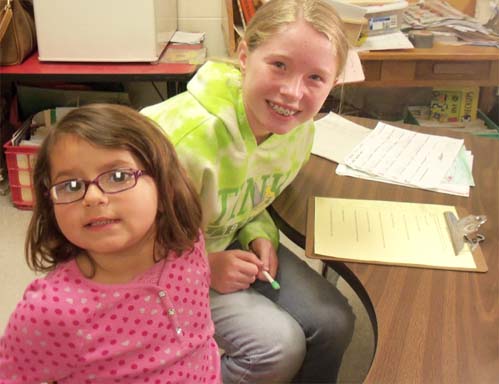
Pink Peepers
By Hope
In the past Mr. K’s class hatched chicks and this year
was no different. Anya is a student in Mr. K’s kindergarten class this
year.
The hatching had a great beginning. Anya said that Mr. K
gave their class the eggs, although Mr. Wisniski and Mr. Zupin donated
them. When Anya first saw the eggs she was excited. She said, “The eggs
were pink!” The first thing Mr. K’s class had to do was put x’s and o’s
on the eggs. They put x’s and o’s on the eggs to help them know when to
turn them over. Anya said that they had to turn the eggs over six times
a day. They only turned them over about two or three times a day though.
THe eggs stayed in the incubator until they hatched, and she said that
it kept them warm. Anya said that candling is getting to see the baby
chicks inside the eggs. She said the chicks grow inside the egg by
eating the yoke.
Peep, peep, hey look! After about 21 days the chicks
hatched. Anya said that when the chicks hatched she thought that the
chicks were cute. She wasn’t sure why there were coins in their food and
water. Although, the coins were in the food and water to help the chicks
learn how to eat. She said that, “The chicks eat their food.” Anya’s
favorite part about hatching the chicks was everything!
Anya and the rest of her class liked hatching the eggs.
The kids in the future will too.

Chirp-a-Mania
By: Trent
Mr. K’s class of 2012 had baby chicks in their classroom.
One of the students in his class is Braydon.
The eggs are here! Braydon said that Mr.K brought in the
eggs for the class. He was very happy to see them. The egg colors were
black, white, and yellow said Braydon. The first thing they did when
they got them was put X’s and O’s on them so they can turn them. They
had to make sure the light was on. They turned them 2 times a day.
Braydon said an incubator is to keep the chicks warm. Candling is a
light to look inside of the egg. Braydon said, “I saw a little black
spot.” The baby chick grew in the by eating the yellow circle in the egg
called the yoke. Braydon loves having the eggs in his classroom.
Peep Peep! Here they come ’’baby chicks’’! It takes 21
days for the eggs to hatch. Braydon said, ‘’I was so excited that the
eggs hatched.” There are coins in their food and water to help them get
to their food and water. The baby chicks eat baby chick food. Braydon
said that he loves to watch them.
It was a great time interviewing Braydon. Braydon had a
great ball of fun.
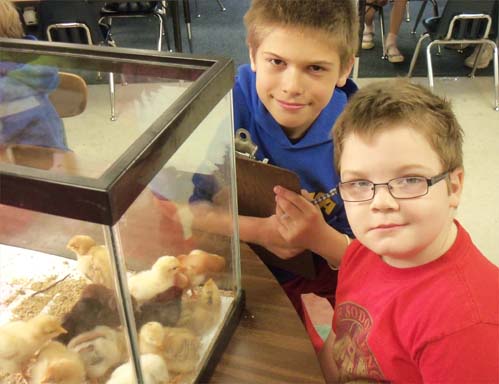
Little Egg/Big Chick
By Ben A.
This year Mr. K’s class had chicken eggs. Jack is a young
five in Mr. K’s class.
Mr. K gave the class the eggs. Jack was very excited when
he first saw the eggs. The eggs were just white. The very first thing we
had to do is put the eggs in the incubator. We put X’s and O’s on the
eggs so we know which side is heated and what side is not. We had to
flip the eggs once a day. Jack says, ”The incubator heats up the up the
chick so they don’t freeze but if it is too hot they will cook up and
die.” Candling is where you put the egg in a tube and put a candle under
it and we see a shadow which is the chick.
Snap Crackle Peep! It took 21 days to hatch. Jack felt
very very excited. There were coins in the water and food so the chicks
could see the shiny coins and the reflection so the chicks would go to
it. The baby chicks eat chick food. Jack said, “It was very exciting and
I was in the excited motion and I was very excited.”
Mr. K’s class had lots of fun having the eggs hatch. It
was a good learning experience.
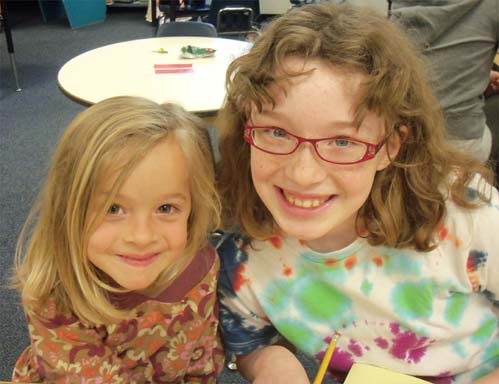
Little Fluffy Chicks!
By: Samantha
This year Mr. K’s class got to hatch chicks. Gwen was one
of those amazing students who got to do this fun project.
Gwen was so excited when Mr. Zupin brought in the eggs.
When she saw the eggs she thought they would come out the twenty first.
The first thing Gwen and her classmates had to do was put X’s and O’s on
each side of the eggs. They put X’s and O’s on the eggs so that each
side of the egg was heated. Something they had to do everyday with the
eggs was to see if they were growing. Gwen said, “We flipped the eggs
over one time a day.” It is normally two or three. The incubator heated
the eggs and if someone opened it Mr. K would tell them to close it.
Candling is when you would put an egg over a light to check to see if
it’s growing. Gwen could see a black eye, the yolk, and the chick. How
do the baby chicks grow? Well they eat the yolk!
Peep peep! Finally after 21 days the chicks are here! The
kindergarten class is gathering around to see their new fluffy chicks!
Gwen felt happy when the chicks hatched. She loves chicks! Mr. K put
coins in the chicks food and water for the brand new chicks so they
could find it. “The chicks would eat some soft corn and cheerios,” Gwen
said. Gwen’s favorite part was when they turned the eggs over.
Gwen had a fun and educational time doing this. So did
the rest of the kindergarten class.

Kindergarten Chicks
By DeeAnn
Mr. K’s class hatches eggs every year. Toni is a student
in Mr. K’s class, and she did the project.
Toni said that the eggs were given to her class by Mr.
Zupin. When the eggs came, Toni was happy. The eggs were blue, and
white. The first thing the class had to do was mark them with X’s and
O’s with a permanent marker. They had to do this so they knew what side
to put the eggs on when they turned them over twice a day. “They do this
to measure heat,” Toni said. The incubator keep the chicks warm so the
chick can grow Toni said. Toni said that the class had to candle the
eggs too. Candling is when you put a light at the bottom of the shadow
and that is the chick. According to Toni, the baby chicks ate the yoke
out of the egg and got bigger.
Cheep, Cheep! After 21 days, the eggs hatched. Toni was
excited when the eggs hatched, and she got to see the baby chicks. Toni
said, “There are coins in the water and food and they shine so the
chicks get water and food.” Toni also said that baby chicks eat a lot
of food. Her favorite thing about hatching eggs is getting to take a
chick home.
Toni had a great time hatching eggs. Toni’s class liked
hatching eggs too.

Hatched
by Colin
Mr. K’s class has been hatching eggs for a while. Ashlyn
is in Mr. K’s class.
This year Mr. Zupin gave the class the eggs. Ashlyn was
very excited when she first seen the eggs. Ashlyn said that they were a
greenish and brown. They put xs and os on the eggs so they know which
side to turn it to. She said, “We turn them about 20 times a day.”
Really it is only 2 or 3 times. The incubator keep the eggs warm.
Candling is when a student takes a flashlight and puts it under an egg
to see what is inside. Most of the time they can see a little black dot.
How does the chick eat in the egg? Ashlyn said that there are little
veins that suck in the yoke and give it to the chick.
Chirp Chirp! The eggs finitely hached! Ashlyn said was
very excited. The eggs took about 21 days to hatch. Mr. K put coins in
the water and food so the chicks know where it is. Ashlyn said, ”My
favorite part was when they hatched.”
Chirp Chirp! Raising chickens is fun and educational.
|
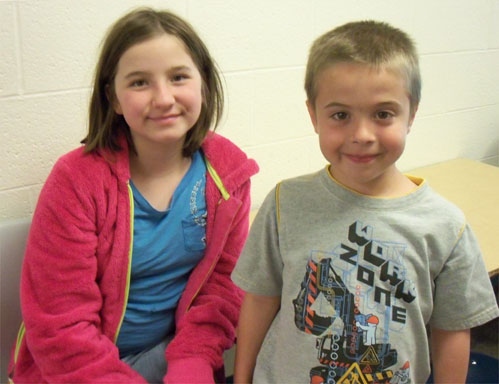
Egg or Chick?
By Kaitlyn
Every year Mr. K’s class hatches eggs. This year Conner
L. is in Mr.K’s class. He hatched eggs!
Let’s start with stage one, getting the eggs. Connor
said Mr. Zupin might have done brought in the eggs. “They were kind of
cool,” says Connor. Our facts so far are, one Mr. Zupin brought the
eggs, they were cool, and last but not least so far they were brown and
white. Now let’s retrace! The first thing they did was put them in the
incubator. Next they put X’s and O’s on the eggs. Why? Of course so
they could turn them. They turned them a lot. Lets go on to the
supplies! The incubator kept the eggs warm. Candling is a light that
you could see the chick’s shadow in. Connor said, “I could see a
shadow.” The chick of course had to grow in the egg by drinking the
yolk.
Cheep cheep! So many chicks! In 21 days the eggs
hatched. Conner was excited! Connor and his friends put coins at the
bottom of the chicks food and water so they can drink it. The hatching
of the chicks made Connor happy.
Yay the eggs are hatched. Conner had lots of fun!
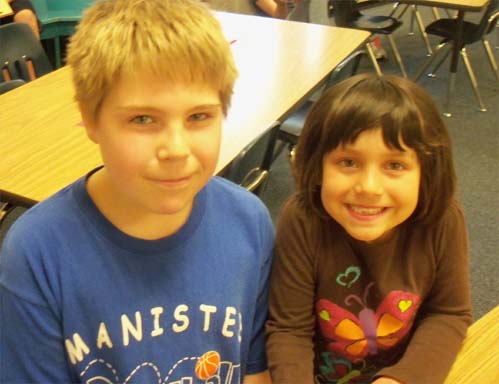
Peepers Peep
By Kyle
In Mr. K’s class 2012 the fifth graders had to interview
one of Mr. K’s kindergarteners about the eggs they helped grow.
The kindergarteners looked so excited at the interview.
Mr. Zupin gave the eggs to the kindergarten class. When she saw the eggs
for the first time she was super happy. Charlize said, “The egg colors
were blue, pink , and brown”. The reason you put X’s and O’s on the
chicks is to keep track what side is warm. Mr.K’s class turns the eggs
two times a day. The incubator keeps the chicks warm so the chicks can
grow. Mr.K’s class seen the chicks grow that is called candling.
Charlize said, “The chick had black stuff on it and you could see the
chick eat the yoke.”
The chicks hatched in 21 days. Tweet tweet tweet the eggs
hatched! Everyone in Mr. K’s class were so happy about the eggs
hatching. Charlize didn’t know about the coins in the water and food.
The chicks eat chick food. She said she like watching them grow.
Mr. K’s class had a fun time watching and learning about
the chicks. Charlize had a exciting time learning and seeing the eggs
grow.

Excited Chicks
By Rylan
This year Mr. K’s class hatched chicks. Grace is a
kindergarten in that class.
Mr. Zupin gave the class the eggs. When Grace first saw
the eggs she was excited. Grace said, “The colors of the eggs were brown
and greenish”. The first thing they did was put X’s and O’s on the eggs.
They put on X’s and O’s to know what side to turn the eggs on. A thing
they did everyday was turn the eggs. They turned the eggs twice a day.
The incubator warmed up the eggs. Candling is where you see the inside
of the egg. When the kids were candling they could see the baby chick.
The chicks eat the yoke when they are in the egg shell.
Chipedy Chipedy! It took 21 days for the chicks to hatch.
Grace said when she saw the chicks hatch that she was, “Excited”. There
is coins in the food and water to show where the food and water is. The
chicks ate chick food. Grace said the most exciting part is when the
chicks were in the tank .
Mr. K’s class had fun hatching chicks. The kids were all
very happy.
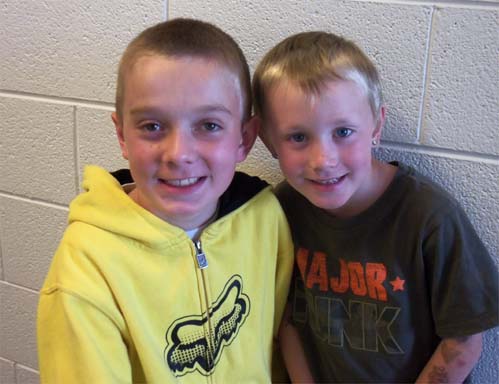
Here Come The Chicks
by Ben J
Every year, Mr. K’s class hatches chicks. Noah is in Mr.
K’s class.
The eggs are here! Mr. Zupin brought the eggs to the
classroom. Noah said that the eggs were brown and white and some had
spots. The first thing to do is put Xs and Os on the eggs. Noah said,
”We did it so the eggs would get the same heat on the sides.” Noah and
his class flipped the eggs twice every day. “The incubator helps the
eggs stay warm and grow,” says Noah. Candling is to look in the egg and
see if the chicks were growing. When Noah did it he could see a chick
and a yolk. The chicks grow by eating the yolk.
PEEP! CHIRP! CHIRP! There’s a head coming out of an egg!
The chicks have arrived after 21 days. Noah said he was very excited
when the eggs hatched. Noah’s class put coins in their food and water to
help the chicks find it. “The chicks eat their chicken food,” said Noah.
Noah’s favorite part about hatching chicks is that he gets to take some
home.
Mr. K’s class had a great time hatching chicks.
Hopefully, future kindergartners do too.

Pop Comes a Chick!
By McKenna
Mr. K’s class hatches chicks each year. Grace was one of
those lucky kids to watch the eggs hatching!
Mr. Zupin had given the class the eggs. “I knew it was
going to be exciting when the eggs hatch,” said Grace. The eggs were
greenish, white, and tan. Right when they got the chicks, they had to
put them in the incubator. They drew x’s and o’s on the eggs so they
knew when when to flip them over. They had to turn them over every day.
They turned them over four or five times a day but according to Grace,
its only once a day. “The incubator is kinda like a hen, it warms the
eggs up like a hen,” explains Grace. Candling is where you put an egg in
a thing Mr. Zupin made that warms up the egg said Grace, but actually,
candling is where you can see the insides of the egg. She says she could
see a dot growing when she candled. The chicks ate the yoke in order to
grow.
How long does it take for an egg to grow you ask? Twenty
one days! Grace was super excited when the eggs hatched. She started
hopping with joy. Every kid would love to watch chicks hatch right? The
kindergarten class put coins in their food and water to show where to
drink and eat. Baby chicks eat grains and corn, in Grace’s words “chick
food.” Grace loved it when the chicks hatched and wrecked the pile of
sand.
Grace and her class had a fun, educational experience!
She wishes that they could do it again!
Interview Lesson
Using their notes the took while interviewing the kindergarten students,
the fifth graders wrote and then typed their report. They inserted a
photo (taken by Mrs. Bennett) at the top of their report. Finished
reports were shared with the kindergarten students. Finished reports
were also emailed to Mrs. Eldridge (school webmaster) for inclusion on
this page. This year every student finished!
There are a total of four interview pages.
Interviews, page 2
Interviews, page 3
Interviews, page 4
Class Index Pages
Mrs. Bennett's
Main 4-5 page
for
2011-2012
Mrs. Brown's Main
5th grade page
for 2011-2012
Mr. Kudlack's Kindergarten Page
for
2011-2012
|